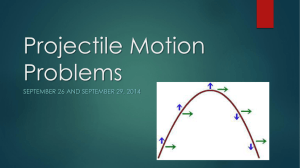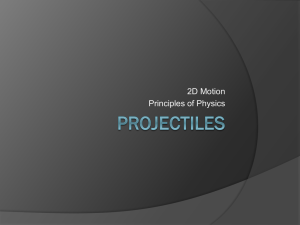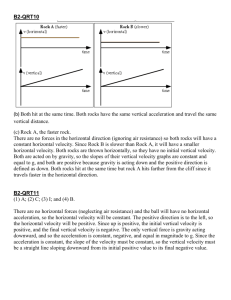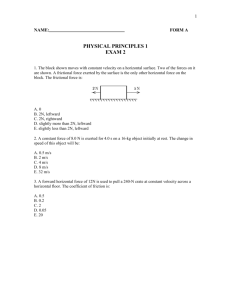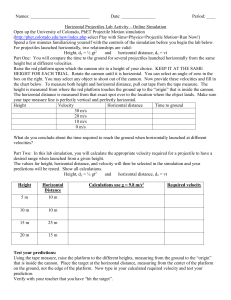PSA key
advertisement
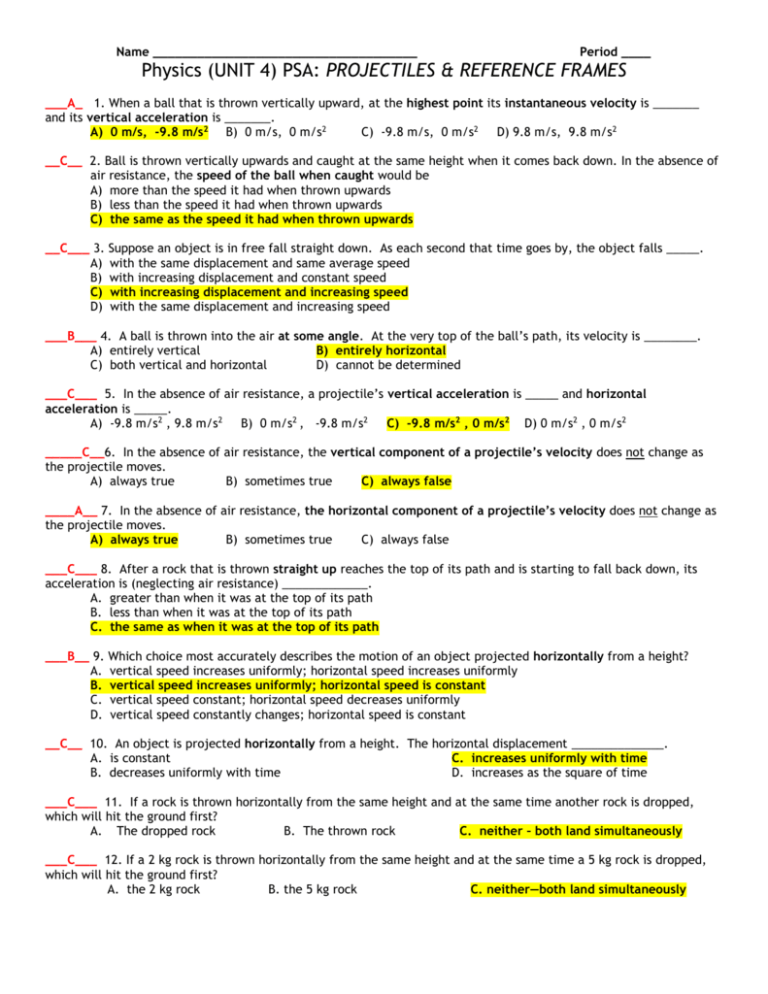
Name ____________________________________ Period ____ Physics (UNIT 4) PSA: PROJECTILES & REFERENCE FRAMES ___A_ 1. When a ball that is thrown vertically upward, at the highest point its instantaneous velocity is _______ and its vertical acceleration is _______. A) 0 m/s, -9.8 m/s2 B) 0 m/s, 0 m/s2 C) -9.8 m/s, 0 m/s2 D) 9.8 m/s, 9.8 m/s2 __C__ 2. Ball is thrown vertically upwards and caught at the same height when it comes back down. In the absence of air resistance, the speed of the ball when caught would be A) more than the speed it had when thrown upwards B) less than the speed it had when thrown upwards C) the same as the speed it had when thrown upwards __C___ 3. Suppose an object is in free fall straight down. As each second that time goes by, the object falls _____. A) with the same displacement and same average speed B) with increasing displacement and constant speed C) with increasing displacement and increasing speed D) with the same displacement and increasing speed ___B___ 4. A ball is thrown into the air at some angle. At the very top of the ball’s path, its velocity is ________. A) entirely vertical B) entirely horizontal C) both vertical and horizontal D) cannot be determined ___C___ 5. In the absence of air resistance, a projectile’s vertical acceleration is _____ and horizontal acceleration is _____. A) -9.8 m/s2 , 9.8 m/s2 B) 0 m/s2 , -9.8 m/s2 C) -9.8 m/s2 , 0 m/s2 D) 0 m/s2 , 0 m/s2 _____C__6. In the absence of air resistance, the vertical component of a projectile’s velocity does not change as the projectile moves. A) always true B) sometimes true C) always false ____A__ 7. In the absence of air resistance, the horizontal component of a projectile’s velocity does not change as the projectile moves. A) always true B) sometimes true C) always false ___C___ 8. After a rock that is thrown straight up reaches the top of its path and is starting to fall back down, its acceleration is (neglecting air resistance) _____________. A. greater than when it was at the top of its path B. less than when it was at the top of its path C. the same as when it was at the top of its path ___B__ 9. Which choice most accurately describes the motion of an object projected horizontally from a height? A. vertical speed increases uniformly; horizontal speed increases uniformly B. vertical speed increases uniformly; horizontal speed is constant C. vertical speed constant; horizontal speed decreases uniformly D. vertical speed constantly changes; horizontal speed is constant __C__ 10. An object is projected horizontally from a height. The horizontal displacement ______________. A. is constant C. increases uniformly with time B. decreases uniformly with time D. increases as the square of time ___C___ 11. If a rock is thrown horizontally from the same height and at the same time another rock is dropped, which will hit the ground first? A. The dropped rock B. The thrown rock C. neither – both land simultaneously ___C___ 12. If a 2 kg rock is thrown horizontally from the same height and at the same time a 5 kg rock is dropped, which will hit the ground first? A. the 2 kg rock B. the 5 kg rock C. neither—both land simultaneously ___B____ 13. An ant travels 1.0 cm/s to the left on a plate relative to the plate as a disgusted picnicker pushes the plate a distance of 4.0 cm/s to the right relative to the earth. What is the relative velocity of the ant with respect to the earth? A) 1.0 cm/s right B) 3.0 cm/s right C) 4.0 cm/s right D) 5.0 cm/s right 14. A stone is simply dropped from a cliff. After it has fallen 689 m, what is the stone’s velocity and how long did it take to fall that distance? Diagram:(Given + Unknowns) a and v Vertical a = -9.8 m/s2 vf = ???? m/s vi = 0 m/s t = ???? s Δdy = - 689 m Equation: a = (vf2 – vi2) / 2Δdy and: ∆ dy = (vi)t + (1/2) a (t)2 Substitute: (-9.8) = (vf2 – (0)2) / 2(-689 ) simplify (-9.8) = vf2 / -1378 half cross mult by -1378 13504 = vf2 then take square root - 116 m/s = vf ∆ dy = (vi)t + (1/2) a (t)2 -689 = (1/2)(-9.8)t2 - 689 = -4.9t2 140 = t2 11.85 s = t Simplify divide by 4.9 take square root. Solve: vf = - 116 m/s t = 11.85 s 15. Harry accidentally falls off of his broom which is traveling horizontally at 15 m/s. He plunges into the water below him 2.0 seconds later. Assuming no air resistance, what is the horizontal distance he travels while falling? Diagram: (Given + Unknowns) Horizontal a = 0 m/s2 vf = 15 m/s vI = 15 m/s t=2s ∆ dx = ??? m Equation: Horizontal: ∆ dx = (vi)t + (1/2) a (t)2 Substitute: ∆ dx= 15 m/s (2 sec) ∆dx = 30 m Solve: ∆dx = 30 m 16. A physics student is practicing her spitball technique. The spit has a horizontal initial velocity of 1.4 m/s while the spitball starts at a height of 2.3 m. What are the velocities of the spitball in the x-direction and y-direction when it hits the ground? What is the resultant velocity when it hits the ground? Use proper vector addition!!! Diagram: (Given + Unknowns) Equation: Vertical: a = (vf2 – vi2) / (2Δdy) then Resultant: a2 + b2 = c2 Horizontal a = 0 m/s2 vf = 1.4 m/s vI = 1.4 m/s t = ???? s Δdx = ??? m Vertical a = - 9.8 m/s2 vf = ??? m/s vi = 0 m/s t = ??? s Δdy = - 2.3 m vnet = ??? m/s Substitute: The horizontal initial velocity vx = 1.4 m/s since the horizontal velocity is constant. Vertical a = (vf2 – vi2) / (2Δdy) vx = 1.4 m/s -9.8 = vf2 / (2(-2.3)) -9.8 = vf2 / -4.6 45.08 = vf2 vy =- 6.71 m/s vnet = ?? m/s Vf = - 6.71 m/s (because its downward) a2 + b2 = c2 (1.4)2 + (-6.71)2 = c2 46.98 = c2 c = 6.85 m/s Solve: vx = 1.4 m/s vy= -6.71 m/s vnet = 6.85 m/s

